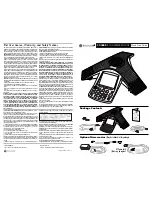
iii
Cisco TelePresence System Release 1.6 Administration Guide
OL-13676-05
Preface
–
Enabled—CTS advertises G.722 to Cisco Unified CM. When enabled, preference is given to
this audio codec.
–
Use System Default—CTS defers to the setting specified in the Advertise G.722 Codec
enterprise parameter.
Note
Enabling G.722 allows the CTS to negotiate G.722 encoding for point-to-point and audio add-in calls
when the
remote side supports it. The selection of G.722 for
HD Interoperability
is controlled by the
codec support in Cisco Unified Videoconferencing (CUVC).
See the Advertise G.722 Codec field in the Product Specific Configuration Layout section of the
Cisco Unified Communications Manager Configuration Guide for the Cisco TelePresence System
for
more information.
Alternate Directory
In Cisco Unified CM Release 7x and later releases you can enter an alternate Cisco Unified CM for
directory lookup. See the Product Specific Configuration Layout section of the
Cisco Unified Communications Manager Configuration Guide for the Cisco TelePresence System
for
more information.
Audio Echo Cancellation
You can enable or disable echo cancellation by checking the Enable Audio Echo Cancellation (AEC)
check-box in the Product Specific Configuration Layout section in the Cisco Unified CM Administration
Phone Configuration window. See the
Cisco Unified Communications Manager Configuration Guide for
the Cisco TelePresence System
for more information.
Cisco TelePresence Recording Server (CTRS)
The Cisco TelePresence Recording Server (CTRS) allows you to do the following:
•
Create recordings.
•
Store recordings on the CTRS.
•
Share recordings with others for viewing.
•
Make recordings public so that anyone with access to the CTRS can view them.
•
Play back recordings on a Cisco TelePresence endpoint.
•
Play back recordings with a standard browser-based player.
•
Download your recordings or public recordings.
CTRS enables you to record in Cisco TelePresence Studio Mode (single endpoint only). This feature is
commonly used for executive and team updates, short training sessions with slides, and colleague
messages. The recording can either be viewed in on a Cisco TelePresence endpoint or from a laptop
through a web link.
To record, users must have access to a CTS with CTRS functionality; the CTS controls recording through
the CTS Cisco Unified IP Phone interface.
See the following documentation for more information:
•
CTRS support documents on the
Cisco TelePresence Recording Server
home page on Cisco.com.
•
The CTRS user chapter in the
Cisco TelePresence System User Guide
on Cisco.com.
















































